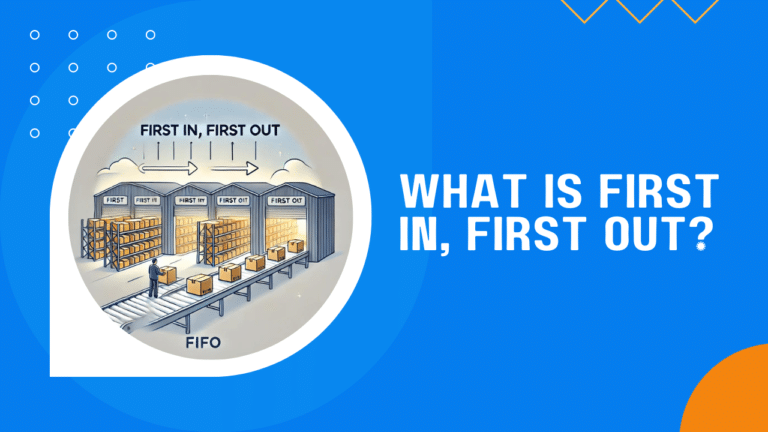Effective inventory management is the backbone of any successful business, ensuring that products are available when customers need them while minimizing waste and costs. Among the various inventory management methods,
First In, First Out (FIFO) stands out as a fundamental and widely used approach. FIFO operates on a simple yet powerful principle: the first items added to inventory are the first to be sold or used. This method is particularly crucial in industries like food, pharmaceuticals, and retail, where product freshness and inventory accuracy are paramount.
By understanding and implementing FIFO, businesses can improve their inventory turnover, enhance customer satisfaction, and ensure compliance with industry regulations. This article will explore the concept of FIFO, its benefits, implementation strategies, and how it compares to other inventory management methods.
What is First In, First Out (FIFO)?
First In, First Out (FIFO) is an inventory management method that dictates that the oldest stock in inventory is sold or used first. This approach ensures that products are rotated systematically, with older items leaving the inventory before newer ones. FIFO is particularly important in industries dealing with perishable goods, such as food and pharmaceuticals, where the freshness of products directly impacts quality and customer satisfaction.
The basic principle behind FIFO is straightforward: items that are first received into inventory are the first to be dispatched or sold. This method contrasts with other inventory management strategies like Last In, First Out (LIFO), where the most recently acquired items are used or sold first. FIFO is favored in many industries because it aligns closely with the natural flow of goods, helping to reduce the risk of spoilage, obsolescence, and waste.
In practice, FIFO not only helps businesses manage their stock more effectively but also plays a significant role in financial reporting. By ensuring that older, often lower-cost items are recorded in the cost of goods sold (COGS), FIFO can provide a more accurate reflection of profits, especially during times of inflation. This accuracy is crucial for businesses seeking to maintain transparency and consistency in their financial statements.
Benefits of Using FIFO
Implementing the First In, First Out (FIFO) inventory method offers several key advantages that can significantly improve the efficiency and accuracy of inventory management. These benefits are particularly valuable in industries where product freshness, cost management, and compliance are critical.
1. Inventory Accuracy
FIFO enhances inventory accuracy by ensuring that older products are sold or used first, thereby reducing the risk of obsolete or expired goods accumulating in the warehouse. This systematic approach to inventory rotation minimizes the likelihood of items being forgotten or overlooked, leading to a more accurate and up-to-date inventory count. In industries like retail and food service, where product expiration can lead to significant losses, FIFO helps businesses maintain a reliable and current stock of goods.
2. Cost Management
Using FIFO can also lead to better cost management, particularly in times of inflation. Because FIFO records the oldest, and often lower-cost, items in the cost of goods sold (COGS), it can result in lower reported costs and higher profits. This method provides a more accurate financial picture by reflecting the actual flow of goods, which is especially beneficial for businesses looking to optimize their financial reporting and potentially reduce tax liabilities.
3. Customer Satisfaction
Another major benefit of FIFO is its positive impact on customer satisfaction. By ensuring that the oldest, and therefore the freshest, products are sold first, FIFO helps businesses deliver high-quality goods to their customers consistently. This is especially important in industries like food and pharmaceuticals, where product freshness directly affects customer health and satisfaction. Customers receiving fresh, well-maintained products are more likely to trust the brand and remain loyal, which can lead to repeat business and positive word-of-mouth.
4. Compliance
In many regulated industries, such as pharmaceuticals and food production, FIFO is often a regulatory requirement. Compliance with FIFO ensures that products are rotated in a manner that maintains their quality and safety standards. By adhering to FIFO, businesses can meet industry regulations more easily, avoiding potential legal issues and ensuring that they are providing safe and effective products to their customers. This not only protects the business but also enhances its reputation as a reliable and responsible provider.
How FIFO is Implemented
Implementing the First In, First Out (FIFO) method effectively requires careful planning, organization, and the right tools. Whether in a warehouse, retail environment, or manufacturing facility, the success of FIFO depends on consistent execution across all levels of inventory management.
1. Warehouse Organization
A well-organized warehouse is essential for FIFO implementation. Proper warehouse layout ensures that older stock is easily accessible, allowing it to be picked and shipped first. This can be achieved by placing new inventory behind or beneath existing stock, making sure that the oldest items are always in front. Clear labeling systems, including date tags and shelf markers, are also crucial for helping staff quickly identify which items need to be dispatched first. Additionally, using designated storage areas for different inventory batches can further streamline the process, reducing errors and improving overall efficiency.
2. Technology and Tools
Inventory management software plays a key role in implementing FIFO. These systems can automatically track the age of inventory, alerting managers when older stock needs to be moved or sold. Barcoding and RFID (Radio Frequency Identification) systems are particularly useful in this regard, as they allow for precise tracking of each item from the moment it enters the warehouse until it is sold or used. By integrating these technologies, businesses can maintain real-time visibility over their inventory, ensuring that FIFO processes are followed consistently.
Tools like an inventory reorder point calculator and a warehouse pricing calculator can also be useful in efficiently managing inventory with FIFO.
3. Training and Procedures
Effective FIFO implementation also requires training staff and establishing clear standard operating procedures (SOPs). Employees need to understand the importance of FIFO and be trained on the specific processes and tools used to maintain it. Regular training sessions and clear, accessible SOPs can help reinforce the correct practices, ensuring that FIFO is consistently applied. Additionally, conducting periodic audits can help identify any deviations from the FIFO process and provide opportunities for corrective action.
Real-World Examples of FIFO
The First In, First Out (FIFO) method is widely used across various industries to manage inventory efficiently and ensure product quality. Here are some real-world examples of how FIFO is implemented in different sectors:
1. Retail Industry
In the retail sector, especially in supermarkets, FIFO is critical for managing perishable goods like dairy products, meats, and produce. For instance, a supermarket might stock newer milk cartons behind older ones on the shelf, ensuring that customers purchase the older stock first. This approach minimizes waste by reducing the chances of products expiring before they are sold, which is essential for maintaining profitability and customer satisfaction. Additionally, FIFO helps retailers keep their inventory fresh, which is crucial for meeting customer expectations for quality.
2. Manufacturing Sector
In manufacturing, FIFO is often used to manage raw materials and components that have a limited shelf life or are susceptible to degradation over time. For example, a food manufacturer might use FIFO to ensure that ingredients like flour, sugar, or preservatives are used in the order they were received, preventing spoilage and maintaining the quality of the finished product. This practice not only improves product consistency but also helps manufacturers comply with safety and quality standards.
3. Ecommerce and Fulfillment Centers
FIFO is employed in fulfillment centers to ensure that customers receive the freshest stock available. For instance, an online retailer might use FIFO to manage inventory in its warehouse, shipping out older stock first to prevent items from becoming outdated or obsolete. This is particularly important for products like electronics or fashion items, where trends and technologies can change rapidly. By using FIFO, ecommerce businesses can reduce the risk of holding unsellable stock and improve customer satisfaction by delivering the latest versions of their products.
In these industries, the successful application of FIFO ensures that businesses minimize waste, maintain product quality, and meet customer expectations. Whether managing food products in a retail environment or ensuring that customers receive the freshest stock in an ecommerce setting, FIFO remains a vital tool for effective inventory management.
FIFO vs. Other Inventory Valuation Methods
When managing inventory, businesses often have to choose between different valuation methods, each with its unique advantages and disadvantages. First In, First Out (FIFO) is just one of several strategies, and comparing it with other methods like Last In, First Out (LIFO) and Weighted Average Cost can help businesses determine the best approach for their needs.
1. FIFO vs. LIFO
Last In, First Out (LIFO) is the opposite of FIFO, where the most recently acquired items are sold or used first. LIFO is often used in industries where inventory costs are rising, as it allows companies to match current costs with current revenues, potentially lowering taxable income during inflationary periods. However, LIFO can lead to older inventory remaining unsold for longer periods, which might increase the risk of obsolescence, especially for perishable goods or items with a limited shelf life.
In contrast, FIFO ensures that older stock is sold first, which is particularly beneficial for industries that deal with perishable goods or where product freshness is crucial. FIFO provides a more accurate reflection of inventory value on the balance sheet during inflationary times, as it typically matches older, lower-cost inventory against current revenues, often resulting in higher reported profits.
2. FIFO vs. Weighted Average Cost
Weighted Average Cost involves calculating the average cost of all items in inventory, regardless of purchase date, and using this average to determine the cost of goods sold (COGS) and ending inventory value. This method is beneficial for businesses that deal with large volumes of similar items, as it smooths out price fluctuations over time.
While Weighted Average Cost provides a simple and consistent approach to inventory valuation, it doesn’t reflect the actual flow of goods as accurately as FIFO does. FIFO is more advantageous when precise inventory rotation is necessary, such as in industries where product freshness or specific lot tracking is critical. Additionally, FIFO can provide more transparency in financial reporting by clearly aligning inventory costs with the actual physical flow of goods.
3. Choosing the Right Method
The choice between FIFO, LIFO, and Weighted Average Cost depends largely on a company’s specific needs, industry, and the economic environment. FIFO is often preferred for its straightforward approach and alignment with the natural flow of goods, making it ideal for industries like food, pharmaceuticals, and retail. LIFO might be advantageous for companies in industries with rising prices that want to minimize tax liabilities. Weighted Average Cost is a middle-ground option, providing consistency and simplicity, but it may not be suitable for businesses where inventory accuracy and freshness are critical.
Although FIFO offers clear benefits in terms of inventory accuracy, cost management, and regulatory compliance, businesses should carefully evaluate their specific circumstances and consider how each method aligns with their operational goals and financial strategies. By choosing the right inventory valuation method, companies can optimize their inventory management practices and enhance overall business performance.
Conclusion: The Importance of FIFO in Effective Inventory Management
First In, First Out (FIFO) is more than just a method for managing inventory; it’s a critical strategy that can significantly enhance a business’s efficiency, product quality, and financial accuracy. By ensuring that the oldest stock is used or sold first, FIFO helps businesses minimize waste, reduce the risk of obsolescence, and maintain the freshness of their products—key factors in industries like food, pharmaceuticals, and retail.
FIFO’s advantages extend beyond inventory control. It also supports better financial reporting by aligning inventory costs with actual product flow, particularly in times of inflation. When compared to other inventory valuation methods, FIFO often emerges as the most straightforward and reliable option for businesses that prioritize accuracy and transparency.
However, the choice of inventory method—whether FIFO, LIFO, or Weighted Average Cost—depends on the unique needs and circumstances of each business. For those dealing with perishable goods or requiring stringent inventory accuracy, FIFO is often the optimal choice. By implementing FIFO effectively, supported by proper warehouse organization, technology, and staff training, businesses can not only improve their inventory management but also boost customer satisfaction and maintain compliance with industry regulations.
Ultimately, adopting the right inventory strategy is essential for sustaining long-term business success, and FIFO remains a foundational method that aligns well with the goals of efficiency, accuracy, and quality.









